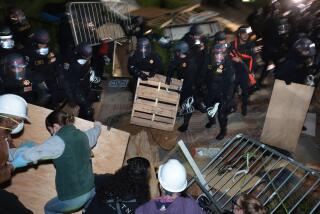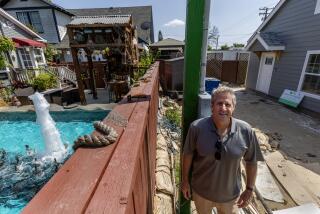Old Bases Battle for New Life
Along a seemingly a pristine stretch of Central California coastline, the Army is digging holes and sifting through a mountain of sand, looking for unexploded artillery shells, rocket propelled grenades and other ordnance buried at the former Ft. Ord infantry base.
The last soldiers marched out of Ft. Ord 10 years ago, but so far the Army has cleared just 5% of the base’s firing range. The Army has unearthed more than 8,000 live shells, and the job could take another 20 years. Even then, Army officials can’t guarantee they will get every last bit of ordnance.
For the record:
12:00 a.m. April 15, 2005 For The Record
Los Angeles Times Friday April 15, 2005 Home Edition Main News Part A Page 2 National Desk 1 inches; 45 words Type of Material: Correction
Military bases -- A map in Sunday’s Section A with an article about the closing and cleanup of military facilities labeled two bases as Hunters Point. The closed facility in California is Hunters Point Naval Shipyard; the one in Maine is Loring Air Force Base.
The issues at Ft. Ord, which overlooks Monterey Bay, mirror a long list of environmental and economic disasters at closed bases across the nation, where critics say the Pentagon has badly mismanaged the cleanup and redevelopment process.
In coming weeks, the Defense Department will unveil its biggest effort yet to eliminate surplus military capacity, ordering the closure of as many as 24% of its facilities. Since 1998, there have been four rounds of military base closures.
“The economic devastation is great,” said Harry Kelso, chairman of Base Closure Partners, an advisor to base communities. “It hits the local schools, the businesses that supported the base, and you lose the direct jobs at the base. Then on top of all that, you have a contaminated piece of property.”
Radioactive contamination, lawsuits, leaking underground tanks, lost jobs, dilapidated buildings, broken promises, asbestos-laden soil and unexploded ordnance are just a sampling of the problems that have led to growing dissatisfaction and in some cases anger on both the military and civilian sides.
In almost every case, it has taken military services far longer than expected to clean up pollution at the facilities and turn the land over to local communities for redevelopment.
And once local agencies have received land deeds and Pentagon assurances that pollution was properly cleaned up, they have typically discovered environmental time bombs.
“We would like to see a lot more funding to get this cleanup moving faster,” said David Brandt, an Alameda, Calif., assistant city attorney involved in redeveloping the former Alameda Naval Air Station, which was shuttered 10 years ago and still has massive contamination. “You have to spin your wheels while you wait for the federal government.”
A significant number of environmental and economic trouble spots are in California, largely because of the state’s huge share of military bases. San Francisco Bay, for example, touches four Superfund pollution sites at former military bases. Other former bases account for 14 Superfund sites across the state.
Defense officials say overall they have done a good job but acknowledge that some base closures have been problematic. There are “frustrations on both sides of the equation,” said Phil Grone, the Pentagon’s top official for the environment and facilities.
Base closures have saved the Defense Department $29 billion and continue to generate savings of $7 billion each year, according to the Government Accountability Office. The GAO found that the Pentagon had passed the halfway point of cleaning up most bases.
As it prepares for more closures, the Bush administration is adopting a new strategy to sell property more quickly. Essentially, it aims to privatize the cleanup and get the military agencies out of long-term environmental and economic relationships with local communities.
The Pentagon is hoping that outright sales of base property will help fund future cleanups, though that prospect is uncertain. One of its most valuable parcels, the former El Toro Marine base in Irvine, fetched far less than expected at an auction this year.
“I think we will be able to do a better job than we have in the past,” Grone said in an interview. “We know a whole lot more now about the environmental condition of our bases.”
Defense officials say they are not at fault for all the delays in getting bases redeveloped. Indeed, El Toro’s redevelopment was delayed by disputes over a proposal to locate a major airport at the base. In other cases, land use restrictions have hampered redevelopment.
But critics say that the military has done a terrible job and that the new policies could make matters even worse.
“You couldn’t design a program to harm communities more economically, even if you intended to do it,” said Saul Bloom, executive director of Arc Ecology, an environmental group in San Francisco that has focused on military base issues. “There are no incentives for the Defense Department to do well. Nobody has ever been promoted to general for doing a good base cleanup.”
Bloom and many local leaders say federal authorities are under-funding the cleanup. The Pentagon has spent about $8.3 billion on cleanup and expects to spend an additional $3.6 billion, figures that critics say are low-ball estimates of a job that could cost many times that when completed.
Even when bases are free of serious contamination or live ordnance, communities struggle to find alternative uses for bases. When the military pulls out, it usually leaves a small self-contained city that has no practical civilian use. Once-guarded main gates are open to anybody who wanders along, including vandals and arsonists.
Almost all closed military bases have hundreds of substandard, decrepit buildings. Sewer systems are minimally functional and not up to civilian standards. Electrical grids and roads must be torn out. Some buildings lack ventilation or heating. Even toilets are an issue.
“We discovered there weren’t any potties,” said Kathy Broderick, senior environmental coordinator in the conversion office at former McClellan Air Force Base outside Sacramento. “They just went out back in the woods.”
That problem may be the least of the concerns at McClellan, one of the most polluted military facilities in the nation. After the base was closed, it was discovered that the Air Force had dug nine undocumented pits and dumped plutonium wastes, heavy metals and other toxins in them.
Pollution problems have delayed development of even seemingly valuable land at closed bases near major cities. After 10 years, the Bay Area’s Alameda complex, for example, has a fraction of the development anticipated. Brandt, the city attorney, said the land may actually have a negative value because of contamination, including a large underground plume of trichloroethylene, a suspected carcinogen.
And as has occurred at many other bases, Alameda discovered new pollution after the Pentagon declared an area clean: After taking possession of an apartment complex, the city discovered it was contaminated with chlordane, a banned pesticide.
The Navy refused to pay for a $4-million cleanup, forcing the city to recover the money from an environmental insurance policy issued by AIG Inc. The insurance giant is now suing the Defense Department, which claims it is protected by “sovereign immunity.”
A similar issue tied up redevelopment at the former Lowry Air Force Base in Denver. A developer building new homes in 2003 discovered the soil was contaminated with asbestos from a military hospital demolished 50 years earlier. Colorado environmental regulators demanded that the asbestos be removed at a cost of $10.5 million.
The city asked the Air Force for compensation, citing the federal law that makes the Defense Department liable for environmental cleanups at former bases. The Air Force balked, saying state officials had grossly overreacted to the asbestos. The dispute appears headed for a lawsuit, said Thomas Markham, head of the local reuse authority.
“There is nothing in the federal regulations that says they don’t have to pay for a cleanup just because they don’t like state standards,” Markham said.
Experts say the discovery of new pollution is the norm rather than the exception at bases.
“Once you put a shovel in the ground, there are always going to be surprises,” said Thomas Swoyer Jr., manager of impaired properties at Western Solutions Corp., a base closure contractor. “In one case, we were digging for asbestos in the soil and found a 500-pound bomb.”
Meanwhile, rural communities often lack the resources to cope with complex development issues. When the Army closed a munitions depot in Seneca County, N.Y., the already economically depressed community lost 900 jobs, said Glenn R. Cooke, executive director of the local reuse authority.
And the county was left with 22 warehouses with caved-in roofs and another 500 steel-reinforced concrete igloos that will cost tens of millions of dollars to demolish. The county tried to get the U.S. Interior Department to take the land as a wildlife refuge, but the agency declined.
“We barely have two nickels to rub together in this county,” Cooke said.
In affluent Monterey, such problems may not seem as relevant, but in fact the surrounding area is struggling economically with high unemployment, and the former Ft. Ord has many problems limiting its development.
The 45-square-mile base looks like it came out of a World War II time capsule with rows of clapboard-sided wooden barracks. The base has 6,000 structures, many contaminated with asbestos, PCBs and lead-based paint. At least 90% of the buildings will have to be demolished, according to Michael Houlemard Jr., executive director of the Ft. Ord Reuse Authority.
In the middle of the base, Army contractors have begun the painstaking job of clearing unexploded ordnance accumulated over five decades. The cleanup of small sections begins with removing brush with an armored lawn mower or by burning, though that can lead to other problems.
In October 2003, the Army began a controlled burn of about 500 acres but lost control and ignited 1,470 acres. It pelted multimillion-dollar homes in Monterey, Carmel and Pacific Grove with ash and soot.
After an area is burned over, workers walk the land and look for visible ordnance to remove. Then teams sweep the area with metal detectors. Every suspicious signal from the detectors must be investigated by digging a hole, often 4 feet deep, with a hand shovel.
When shells are found, they are detonated nearby, which reverberates all the way to downtown Monterey. Along with the shells, the Army has removed 3.2 million shards of rusty metal scrap.
“The fragments are driving us crazy,” said Clinton Huckins, the Army Corps of Engineers safety and quality assurance chief at the cleanup. “It is very time consuming out there, very expensive.”
What’s more, there is no standard for cleaning up ordnance, unlike environmental standards for carcinogens or other toxins. The issue is being studied and debated by the Environmental Protection Agency and the Defense Department.
In the meantime, nobody is sure how clean is clean enough. In one area, the Army has scraped 2 feet of soil into a giant sandy mound that it will begin sifting in coming weeks.
“We can’t guarantee anything,” Huckins said. “It is buyer beware.”
More to Read
Start your day right
Sign up for Essential California for news, features and recommendations from the L.A. Times and beyond in your inbox six days a week.
You may occasionally receive promotional content from the Los Angeles Times.







